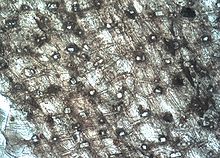- Druse (botany)
-
Druse are groups of crystals of calcium oxalate[1], silicates or carbonates present in plants. Calcium oxalate (Ca(COO)2, CaOx) crystals are found in algae, angiosperms and gymnosperms in a total of more than 215 families. These plants accumulate oxalate in the range of 3%-80% (w/w) of their dry weight [2][3] via a biomineralization process in a variety of shapes. [4] Araceae have numerous druse, multi-crystal druse and needle shaped raphide crytals of CaOx present in the tissue.[5] Druse are also found in leaves and bud scales of Prunus, Roses, [6] Allium, Vitus, Morus and Phaseolus. [7], .[8] The poisonous substances in druse are thought to be a prevention from herbivorage.
How Druse are Formed
A number of biochemical pathways for calcium oxalate biomineralization in plants have been proposed. Among these are the cleavage of isocitrate, the hydrolysis of oxaloacetate, glycolate/glyoxylate oxidation, and/or oxidative cleavage of L-ascorbic acid.[9] The cleavage of ascorbic acid appears to be the most studied pathway.[10][11][12][13] The specific mechanism controlling this process is unclear but it has been suggested that a number of factors influence crystal shape and growth, such as proteins, polysaccharides, and lipids or macromolecular membrane structures.[14][15][16] Druse may also have some purpose in calcium regulation.
See also
- Raphide
- Idioblast
- Phytolith
- protection against herbivory.
References
- ^ Franceschi VR, Nakata PA (2005) Calcium oxalate in plants: formation and function. Annu Rev Plant Biol. 56:41-71.
- ^ Zindler-Frank E (1976) Oxalate biosynthesis in relation to photosynthetic pathways and plant productivity: a survey. Z Pflanzenphysiol. 80:1-13.
- ^ Libert B, Franceschi VR (1987) Oxalate in crop plants. J Agric Food Chem. 35:926-938.
- ^ McNair JB (1932)The interrelations between substances in plants: essential oils and resins, cyanogen and oxalate. Am J Bot. 19:255-271.
- ^ Prychid CJ, Jabaily RS, Rudall PJ (2008) Cellular ultrastructure and crystal development in Amorphophallus (Araceae). Ann Bot (Lond). 101(7):983-995.
- ^ Lersten NR, Horner HT (2006) Crystal macropattern development in Prunus serotina (Rosaceae, Prunoideae) leaves. Ann Bot (Lond). 97(5):723-729.
- ^ Jáuregui-Zúñiga D, Reyes-Grajeda JP, Sepúlveda-Sánchez JD, Whitaker JR, Moreno A (2003) Crystallochemical characterization of calcium oxalate crystals isolated from seed coats of Phaseolus vulgaris and leaves of Vitis vinifera. J Plant Physiol. 160(3):239-245.
- ^ Katayama H, Fujibayashi Y, Nagaoka S, Sugimura Y (2007) Cell wall sheath surrounding calcium oxalate crystals in mulberry idioblasts. Protoplasma. 231(3-4):245-248.
- ^ Hodgkinson A (1977) Oxalic acid metabolism in higher plants. In A Hodgkinson, ed, Oxalic Acid Biology and Medicine. Academic Press, New York, pp 131-158.
- ^ Yang J, Loewus FA (1975) Metabolic conversion of L-ascorbic acid in oxalate-accumulating plants. Plant Physiol. 56:283-285.
- ^ Nuss RF, Loewus FA (1978) Further studies on oxalic acid biosynthesis in oxalate-accumulating plants. Plant Physiol. 61:590-592.
- ^ Li XX, Franceschi VR (1990) Distribution of peroxisomes and glycolate metabolism in relation to calcium oxalate formation in Lemna minor L. Eur J Cell Biol. 51:9-16.
- ^ Keates SA, Tarlyn N, Loewus FA, Franceschi VR (2000) L-Ascorbic acid and L-galactose are sources of oxalic acid and calcium oxalate in Pistia stratiotes. Phytochemistry. 53:433-440.
- ^ Horner HT, Wagner BL (1980) The association of druse crystals with the developing stomium of Capsicum annuum (Solanaceae) anthers. Am J Bot. 67:1347-1360.
- ^ Arnott HJ, Webb MA (1983) Twin crystals of calcium oxalate in the seed coat of the kidney bean. Protoplasma. 114:23-34.
- ^ Webb MA (1999) Cell-mediated crystallization of calcium oxalate in plants. Plant Cell. 11:751-761.
Categories: Plant physiology
Wikimedia Foundation. 2010.

